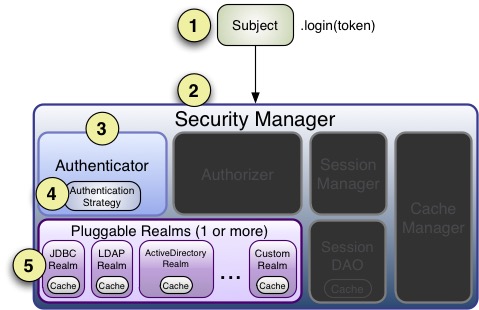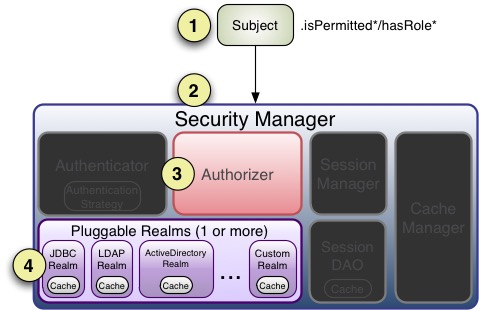Shiro 快速指南
/* 收集实体+凭据 */
//Example using most common scenario of username/password pair:
UsernamePasswordToken token = new UsernamePasswordToken(username, password);
//”Remember Me” built-in:
token.setRememberMe(true);
/* 提交实体+凭据 */
Subject currentUser = SecurityUtils.getSubject();
currentUser.login(token);
/* 认证处理 */
try {
currentUser.login(token);
} catch ( UnknownAccountException uae ) { ...
} catch ( IncorrectCredentialsException ice ) { ...
} catch ( LockedAccountException lae ) { ...
} catch ( ExcessiveAttemptsException eae ) { ...
} ... catch your own ...
} catch ( AuthenticationException ae ) {
//unexpected error?
}
currentUser.logout(); //removes all identifying information and invalidates their session too.
如果login方法执行完毕且没有抛出任何异常信息,那么便认为用户认证通过。之后在应用程序任意地方调用SecurityUtils.getSubject() 都可以获取到当前认证通过的用户实例,使用subject.isAuthenticated()判断用户是否已验证都将返回true. 相反,如果login方法执行过程中抛出异常,那么将认为认证失败。Shiro有着丰富的层次鲜明的异常类来描述认证失败的原因,如代码示例。

Realm将调用getAuthenticationInfo(token); getAuthenticationInfo 方法就是实际认证处理,我们通过覆盖Realm的doGetAuthenticationInfo方法来编写我们自定义的认证处理。
/* 编程方式 */
/* 对象 */
Permission printPermission = new PrinterPermission("laserjet4400n", "print");
Subject currentUser = SecurityUtils.getSubject();
if (currentUser.isPermitted(printPermission)) {
//show the Print button
} else {
//don't show the button? Grey it out?
}
/* 字符串 */
Subject currentUser = SecurityUtils.getSubject();
if (currentUser.isPermitted("printer:print:laserjet4400n")) {
//show the Print button
} else {
//don't show the button? Grey it out?
}
/* 断言:对象 */
Subject currentUser = SecurityUtils.getSubject();
//guarantee that the current user is permitted
//to open a bank account:
Permission p = new AccountPermission("open");
currentUser.checkPermission(p);
openBankAccount();
/* 断言:字符串 */
Subject currentUser = SecurityUtils.getSubject();
//guarantee that the current user is permitted
//to open a bank account:
currentUser.checkPermission("account:open");
openBankAccount();
/* 注解方式 */
@RequiresAuthentication
public void updateAccount(Account userAccount) {
//this method will only be invoked by a
//Subject that is guaranteed authenticated
...
}
@RequiresPermissions("account:create")
public void createAccount(Account account) {
//this method will only be invoked by a Subject
//that is permitted to create an account
...
}

protected AuthenticationInfo doGetAuthenticationInfo(AuthenticationToken authcToken) throws AuthenticationException {
UsernamePasswordToken token = (UsernamePasswordToken) authcToken;
User user = accountManager.findUserByUserName(token.getUsername());
if (user != null) {
return new SimpleAuthenticationInfo(user.getUserName(), user.getPassword(), getName());
} else {
return null;
}
}
protected AuthorizationInfo doGetAuthorizationInfo(PrincipalCollection principals) {
String userName = (String) principals.fromRealm(getName()).iterator().next();
User user = accountManager.findUserByUserName(userName);
if (user != null) {
SimpleAuthorizationInfo info = new SimpleAuthorizationInfo();
for (Group group : user.getGroupList()) {
info.addStringPermissions(group.getPermissionList());
}
return info;
} else {
return null;
}
}
<bean id="securityManager" class="org.apache.shiro.mgt.DefaultSecurityManager">
<property name="cacheManager" ref="cacheManager"/>
<property name="sessionMode" value="native"/>
<!-- Single realm app. If you have multiple realms, use the 'realms' property instead. -->
<property name="realm" ref="myRealm"/>
<property name="sessionManager" ref="sessionManager"/>
</bean>
<bean id="shiroFilter" class="org.apache.shiro.spring.web.ShiroFilterFactoryBean">
<property name="securityManager" ref="securityManager"/>
<property name="loginUrl" value="/login.jsp"/>
<property name="successUrl" value="/home.jsp"/>
<property name="unauthorizedUrl" value="/unauthorized.jsp"/> -->
<property name="filterChainDefinitions">
<value>
/admin/** = authc, roles[admin]
/docs/** = authc, perms[document:read]
/** = authc
</value>
</property>
</bean>
权限声明及粒度 Shiro权限声明通常是使用以冒号分隔的表达式。就像前文所讲,一个权限表达式可以清晰的指定资源类型,允许的操作,可访问的数据。同时,Shiro权限表达式支持简单的通配符,可以更加灵活的进行权限设置。 下面以实例来说明权限表达式。 可查询用户数据 User:view 可查询或编辑用户数据 User:view,edit 可对用户数据进行所有操作 User:* 或 user 可编辑id为123的用户数据 User:edit:123
Shiro可以通过配置文件实现基于URL的授权验证。FilterChain定义格式: URL_Ant_Path_Expression = Path_Specific_Filter_Chain
URL表达式说明 1、URL目录是基于HttpServletRequest.getContextPath()此目录设置 2、URL可使用通配符,**代表任意子目录 3、Shiro验证URL时,URL匹配成功便不再继续匹配查找。所以要注意配置文件中的URL顺序,尤其在使用通配符时。
Filter Chain定义说明 1、一个URL可以配置多个Filter,使用逗号分隔 2、当设置多个过滤器时,全部验证通过,才视为通过 3、部分过滤器可指定参数,如perms,roles
Shiro内置的FilterChain
| Filter Name | Class |
|---|---|
| anon | org.apache.shiro.web.filter.authc.AnonymousFilter |
| authc | org.apache.shiro.web.filter.authc.FormAuthenticationFilter |
| authcBasic | org.apache.shiro.web.filter.authc.BasicHttpAuthenticationFilter |
| perms | org.apache.shiro.web.filter.authz.PermissionsAuthorizationFilter |
| port | org.apache.shiro.web.filter.authz.PortFilter |
| rest | org.apache.shiro.web.filter.authz.HttpMethodPermissionFilter |
| roles | org.apache.shiro.web.filter.authz.RolesAuthorizationFilter |
| ssl | org.apache.shiro.web.filter.authz.SslFilter |
| user | org.apache.shiro.web.filter.authc.UserFilter |